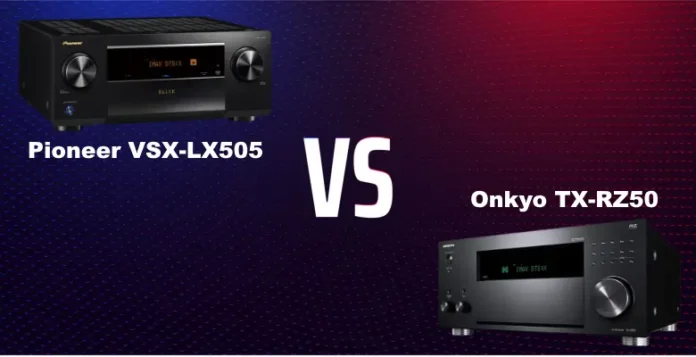If you’re really trying to re-create the genuine movie-theater experience at home, there’s simply no replacement for a powerful Audio Video Receiver or AVR. These devices serve as the central hub for your speakers, projector or TV, and content sources, optimizing the signal that goes to each along with making them more convenient to control.
In the world of high-end AVRs, Onkyo and Pioneer are brand names you might hear. For both of these high-end Japanese companies, you can find a range of options suitable for a modern home theater, with the models in review today being among their newest and most advanced models.
Comparing the Pioneer VSX-LX505 and the Onkyo TX-RZ50 (>>> Find on Amazon), you’ll see both offer impressive sound and video quality, along with smart features like voice control. The models, indeed, are quite comparable, with one of the main differences being that the Pioneer is a negligible $100 more in price.
Before we get into full reviews of each AVR, let’s take a look at the ways in which these AVRs are similar or different.
Pioneer VSX-LX505 vs Onkyo TX-RZ50 Side by Side:
| Pioneer VSX-LX505 | Onkyo TX-RZ50 | |
|---|---|---|
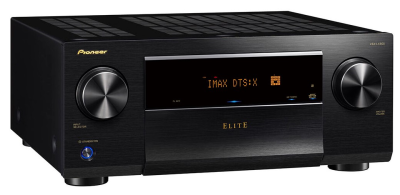 | 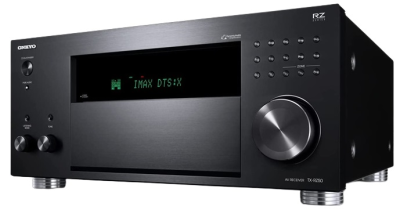 |
|
| Video | 8K/60Hz, 4K/120Hz | 8K/60Hz, 4K/120Hz |
| Amplifier | 9.2 channel (120W per channel) | 9.2 channel (120W per channel) |
| Sound | Up to 11.2, Dolby Atmos Height Virtualization, DTS formats | up to 11.2 Dolby Atmos |
| Wi-Fi | Yes | Yes |
| Bluetooth | Yes | Yes |
| Price | Find on Amazon B&HPhotoVideo | Find on Amazon B&HPhotoVideo |
Calibration
Both AVR’s come with advanced room correction capabilities. The Onkyo TX-RZ50 has Dirac Live ™ and AccuEq Room Corrections, and the Pioneer Elite VSX-LX505 has the advanced MCACC and Dirac Live ™ Room Correction. These calibration solutions allow for better sound quality in addition to reducing time delays.
Set-up and Installation
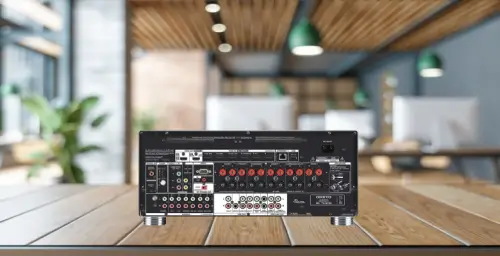
You don’t need to be an AVR expert to set up either of these receivers. Although both devices have a lot of inputs and outputs, they are labeled and intuitively laid out. After connecting your AVR device to the TV, simply press the home button on the remote to get to the main screen then go through the recommended steps.
In addition to following the main steps, the Onkyo will require a Firmware Update, which will need to be downloaded from the Onkyo website. After the Firmware Update, there are four steps including: speaker setup, multi zone sound check, arc setup, and Dirac Live ™ setup.
Easier to install: Pioneer VSX-LX505
Pioneer VSX-LX505
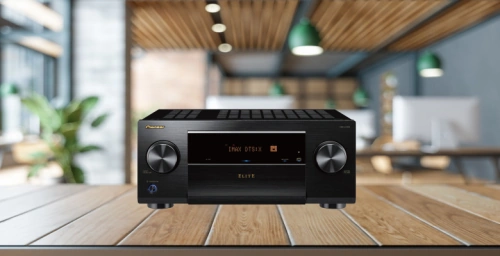
The Pioneer VSX-LX505, introduced in 2021, uses the most advanced visual and audio processing technology you’ll find on the current market. This includes 8K-ready video processing, with dynamic HDR10+ support for impressive contrast, color, and clarity for all your movies and TV shows.
In addition to impressive visuals, don’t forget the sound processing on the Pioneer VSX-LX505, which is just as sensational. The Pioneer VSX-LX505 uses Pioneer’s Advanced Sound Retriever which allows you to hear sound the way the artist intended it by restoring data that tends to get lost in the digital compression process. Along with that, you’ll enjoy this AVR’s DTS:X with its Neural:X upmixer for realistic, powerful sound with no signal loss.
To top it all off, the Pioneer VSX-LX505 is user-friendly with the Pioneer Remote App on iPhone, iPad, or Android. It’s great for smart home users, too, with voice control through Amazon Alexa, Siri (via Apple AirPlay 2), or Google Assistant. Click here for our more in-depth Pioneer VSX-LX505 review.
Pros
- DIRAC Live Room Correction
- Supports video resolutions up to 8K
- Built-In Streaming (Spotify, Pandora, etc.)
- Enhanced 4K Gaming
- Multi-Channel Music File Playback via USB
Cons
- Inputs (no USB type B input for digital input/dsd DoP)
- Does not allow individual crossover settings for the speakers
- Mobile app a little finnicky
- $100 more than the Onkyo
Onkyo TX-RZ50

For sound and video quality, you’ll get the same impressive stats from the Onkyo TX-RZ50 that you’ll find on the Pioneer VSX-LX505 above. This includes Dolby Atmos, DTS:X, and IMAX sound, and support for video resolutions up to 8K. It’s a great system for movies, music, or gaming, with support for multi-room music and direct streaming from apps like Pandora and Spotify. The Onkyo TX-RZ50 has THX Certification which ensures that the viewing and listening experience has passed critical industry standards. The Pioneer VSX-LX505 on the other hand, does not have THX Certification, which guarantees Onkyo’s quality.
The Onkyo TX-RZ50 is also easy to integrate into smart home theater systems. It has the same wide voice control compatibility and comes with the on-screen setup app that makes it easy to get started. We appreciate the inclusion of the DIRAC speaker calibration system, which lets you calibrate all your speakers together to optimize your listening experience. Click here for our full Onkyo TX-RZ50 review.
Where the Onkyo TX-RZ50 really excels is in its versatility. It’s built to power 9.2 systems right out of the box, with processing power that allows you to expand that up to 11.2 channel processing. This also opens up the option of 7.2.4 sound systems with overhead speakers, so you’ll get more configuration options as well as the power to drive more speakers.
The inputs and outputs on the Onkyo TX-RZ50 are equally robust. There are 8 HDMI ports in total, along with a range of other connections that even includes a phono input for connecting a turntable. This is in addition to its Bluetooth and Wi-Fi connectivity. Even the largest and most complex home theaters will be able to run through the Onkyo TX-RZ50.
Pros
- DIRAC Live Room Correction
- THX Certification
- PLL Jitter Reduction
- Supports video resolutions up to 8K
- Dynamic Audio Amplification
- T-D (Theater-Dimensional) Virtual Speakers
Cons
- Often on backorder
What’s the Final Verdict?
Ultimately, there are a lot of AVR’s on the market to choose from. The Pioneer VSX-LX505 and the Onkyo TX-RZ50 are at the higher end of AVR’s with a lot of the same components as well as great capacities for your home theatre.
The Pioneer VSX-LX505 and the Onkyo TX-RZ50 use the same high-level audio and video processing technology, so they’ll both give you a superior home theater experience. Both also work well with an array of smart home systems and are 8K ready, making them great long-term investments.
Choosing between these two AVR’s really comes down to flexibility. The Pioneer VSX-LX505 does not allow individual crossover settings for the speakers; whereas the Onkyo TX-RZ50 allows individual crossover for the Front (Left – Right), Center, Side Surrounds, Read Surrounds, and Ceiling (>>> Check the current price on Bhphotovideo).
Ultimately, you’ll be impressed with the convenience and quality of either of these AVR’s. We hope this comparison has helped you decide which is the right choice for your home theater!
